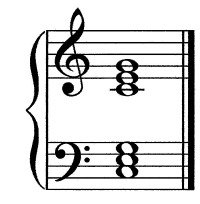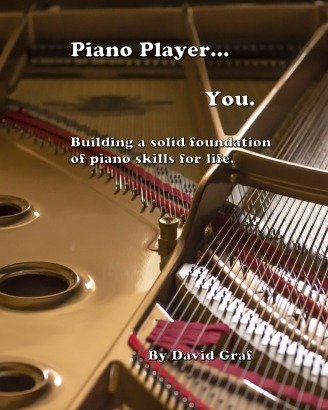The purpose of this website: helping you learn to play the piano. Building a strong foundation of piano-playing skills will lead to a lifetime of piano-playing joy.
Piano Chords:
building your keyboard awareness & knowledge

Piano Chords, along with the piano scales, are the basic building blocks of most piano music. Learning the chords develops your keyboard awareness, and enhances your understanding of the music you read, memorize, compose, or improvise. You can get to know these basic building blocks by making them a part of your regular practice routine.
Once you have become familiar with the 12 major triads and the 12 minor triads in root position, you can begin learning how to invert them, voice them differently, spread them out, use them in melodies, and create accompaniment patterns with them. You will also find the triads handy for analyzing piano pieces you might be reading or memorizing. Thus the process of learning how to play the music (and memorize it) becomes much easier than if you had no such knowledge of chords.
The first chords a pianist should learn are the Major Triads and the Minor Triads. ("Triad" refers to a 3-note chord.) I've found that the best way for beginning students to learn these chords is by grouping them according to their appearance on the keys,or what I call their "keyboard image".
For a more complete understanding of how to build your piano-playing foundation, read
For the most direct, organized, and progressive path to learning to play the piano, start
the Piano Skills Foundation series of piano lessons.
(Advertisement)
Piano Chords: Major & Minor Triads' "Keyboard Image"
To find the major and minor triads grouped according to keyboard image, go to "keyboard chords I" (major triads), or "keyboard chords II" (minor triads).
Major & Minor Triads: Chromatically
Once you've learned the chords in these groups, the next step is to play them chromatically: up and down in half-steps. Thus, you will find the same major and minor triads listed in half steps if you go to "Major & Minor Triads".
Once you know these triads in root position and can play them proficiently up and down in half-steps for at least one octave, try playing them around the circle of 4ths. This will not only increase your knowledge and feel for each chord, but will improve your keyboard awareness.
To learn more about developing keyboard awareness, go from "Piano Chords" to "Free Piano Lessons".
Video: Major & Minor Triads
(a progression of learning)
Diminished Triads
The diminished triads are also handy to know.
To see the diminished triads, listed chromatically, go to "Diminished Chords".
The Common Chords By Root:
A Chords
A-flat Chords
B Chords
B-flat Chords
C Chords
C-sharp Chords
D Chords
D-flat Chords
D-sharp Chords
E Chords
E-flat Chords
F chords
F-sharp Chords
G Chords
G-flat Chords
G-sharp Chords
Inversions
-click here to take the next step in your chord-playing skills: chord inversions!!!
-click here for more about chords-

If you want to see a blueprint for a successful piano journey...
read
"Piano Player... You"
A guide to building a solid and complete piano-playing foundation.
-Click here to learn more about this e-book-
If you would like a step-by-step guide to help you on your piano journey...
start working through
"The Piano Skills Foundation" piano lessons
-Click here to learn more about this piano course-
Looking for some piano music?
I have found Sheet Music Plus to be a fantastic resource for piano books & other materials. And they have instant digital downloads for thousands of individual pieces.
3 Ways To Support This Website
If you enjoy using true-piano-lessons.com and would like to help support it:
1. Buy the ebook, "Piano Player... You"
2. Purchase "Piano Skills Foundation"
3.Donation
